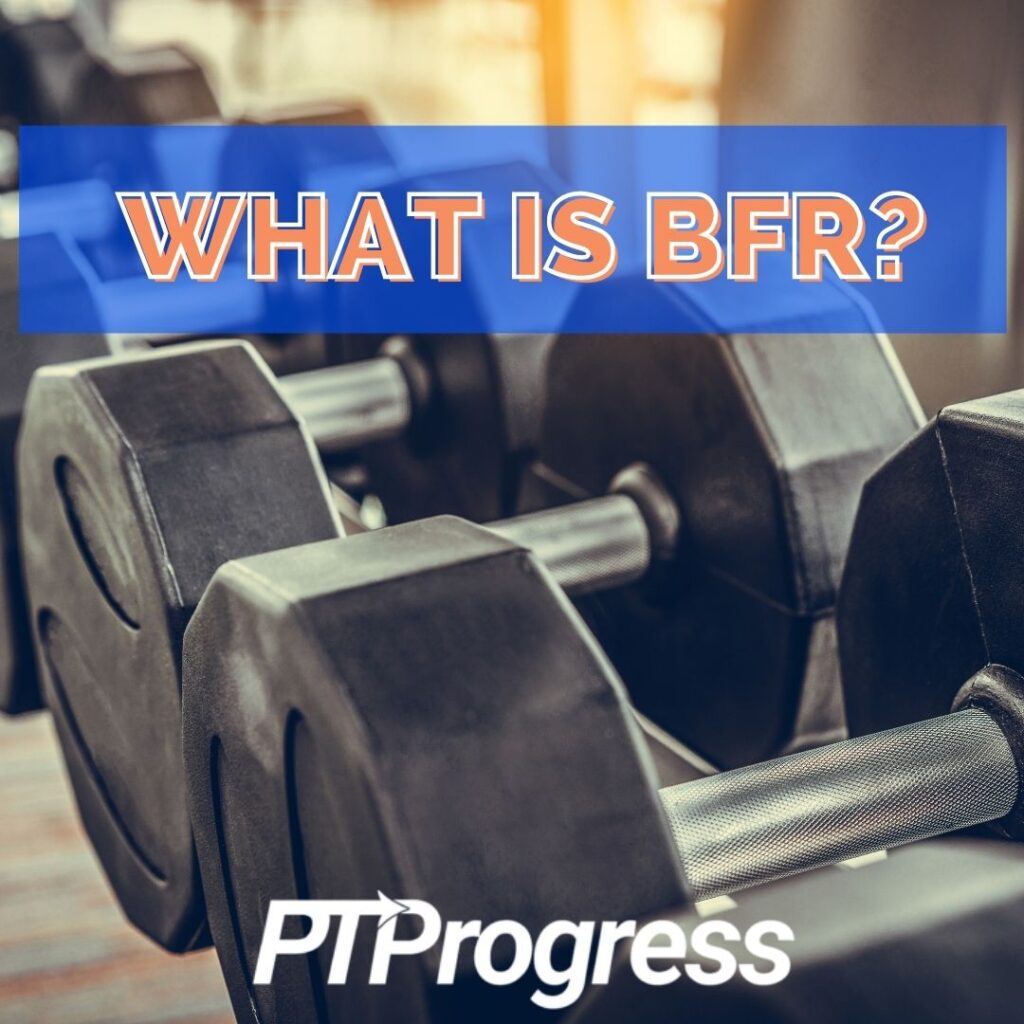
Blood-flow restriction (BFR) is a technique for building muscle mass without using heavy weights. Sound impossible? Although this technique might seem new to you, the science behind it has been researched for decades. And if you’re a PT, many of your patients could benefit from this training.
BFR Training: How It Works
Blood-flow restriction training, also known as vascular occlusion, works by securing a tight cuff or tourniquet around the upper arm or upper thigh, depending on the targeted muscle. The cuff is then inflated until arterial blood flow is occluded, usually around 40-80%.
“Occlusion” simply means that the blood flow beneath the cuff is one-way: flowing in from the heart but not returning to the heart. In the meantime, the deoxygenated blood will pool and the muscle will swell.
Under this restriction, the patient then executes modified weight-lifting exercise or bodyweight exercise. Typically, BFR workouts use light weights with high repetition and minimal rest in between sets. Blood-Flow Restriction should be supervised by a therapist or athletic trainer unless expressly permitted otherwise.
Why It Works
The underlying principle behind BFR is the muscle’s response to overload. Muscle growth begins only when a muscle is fatigued enough to enter hypoxia, a state of reduced oxygen in the muscle. In response to hypoxia, the brain releases growth hormones to enlarge muscles and build new cells. Decreasing blood flow to the muscle site essentially short-circuits the hypoxia process by robbing the muscles of oxygenated blood.
The Role of Fast-Twitch Muscles
Another reason why Blood-Flow Restriction works is because under restricted oxygen, the body is forced to make muscular adaptations. Your muscles are made of two different types of fibers: slow-twitch for aerobic demands (walking, swimming, cycling) and fast-twitch for anaerobic demands (sprinting, weight-lifting).
As the building blocks of endurance, long-lasting slow-twitch muscle fibers rely on a steady flow of oxygen-rich blood (hence the “aerobic” term). In contrast, fast-twitch muscle fibers operate despite oxygen deprivation, enabling you to sprint down the track before catching your breath.
Generally, such high-intensity, anaerobic activities are the only way to overload fast-twitch fibers and increase muscle size. However, by using blood-flow restriction, you’ll put your deoxygenated slow-twitch fibers out of commission. Your fast-twitch muscle fibers will then kick in to complete the exercise.
By excluding slow-twitch muscle fibers, you’ll quickly fatigue the fast-twitch muscles and reach overload.
Why It’s Beneficial
Blood-flow restriction works so well because it’s essentially a shortcut to high-intensity exercise. Athletes can shorten the time it takes to overload their muscles and kickstart growth without needing to lift dangerously heavy weights.
For instance, in order to build muscle mass, typically you must stress muscles to about 65% of maximum strength, or, if you’re bench-pressing, the amount of weight you can press only one time. If your “one-rep max” is 200 pounds, then you should repeatedly press 130 pounds.
However, with BFR, you could lift or press just 20-30% of your one-rep max, or 40-60 pounds. With such low training volumes, you’ll limit the damage to your muscles without compromising on results. And because your fast-twitch muscle fibers expedite the growth process, BFR training will help you reach your goals in muscle size and growth at a much faster rate.
Who Should Use BFR?
BFR training isn’t just for bodybuilders. While it can boost muscle size and bolster bulk-up efforts, the principle of expedited muscle growth can benefit many other purposes as well.
BFR and Physical Therapy
For instance, a physical therapy patient with a musculoskeletal injury in their legs or arms could use BFR to promote muscle growth and speed recovery. BFR can be used after an operation to combat muscle loss without putting stress on the operative joint. Because BFR is effective with little to no weight, injured patients won’t risk over-exertion.
Instead of resistance training, physical therapy patients can also employ BFR for aerobic activities such as walking or cycling, with similar results in stimulated muscle growth. Finally, the benefits of BFR extend to passive activities – vascular occlusion without undergoing exercise or resistance training.
Because of its low impact and low risk of injury, BFR is an appropriate training resource for all kinds of patients – the athletic, elderly, or even post-operative.
Who Shouldn’t Use BFR?
As with any medical advice, there are “contraindications,” or cases in which BFR is not safe or beneficial. The nature of vascular occlusion poses a significant risk to patients with high blood pressure and clogged arteries.
Patients who are obese, diabetic, pregnant, or at risk of blood clots should not attempt BFR. When starting out, only perform BFR under trained supervision, such as in a sports or PT clinic.
In general, BFR is a safe method for low-impact workouts with high-intensity results. However, while undergoing BFR training, you may experience discomfort at the site of occlusion, feel faint or dizzy, or have delayed onset muscle soreness. Improper use of the tourniquet or cuff can lead to more serious injuries, such as nerve injury and skin damage.
These side effects are extremely rare, however. By seeing a professional and following basic precautions, you’ll guarantee a safe BFR experience.
Does BFR really work?
The science might be compelling enough, but what does the research show?
BFR training increases power, endurance, and strength regardless of demographic and ability.
To put it in numbers, research has shown that BFR resistance training can contribute up to 56% growth in muscle protein synthesis, a 31% increase in muscle strength, and a 20% increase in muscle size (as opposed to a 13% increase among individuals who did resistance training without BFR).
BFR also improves muscular endurance, as evident in studies on BFR training for aerobic exercise. Participants who walked or cycled with BFR demonstrated a 7-27% increase in skeletal muscle mass.
Even passive BFR, or vascular occlusion without exercise, has displayed beneficial results in research. In this experimental study, participants who underwent passive BFR experienced less muscle atrophy (9% loss) following knee surgery than the control group did (20% loss). Reducing muscle atrophy with BFR ultimately reduces time spent on post-op rehabilitation.
BFR Training: How to Get Started
If you’re ready to give Blood-flow Restriction Training a try, contact your physical therapist or athletic trainer. Although it’s possible to do BFR on your own at home, you’ll get the best results by working with someone who has the requisite knowledge and professional skills to ensure your training program is successful.
Your certified BFR trainer will help you establish a workout routine. Depending on your goals and method for BFR, your workout might involve weight-lifting, walking, or passively restricting blood flow following a therapy treatment.
Your AT or PT will apply the cuff to your upper arm or upper thigh and inflate it until it is 40-80% occluded. The strap will feel uncomfortable, but if you experience numbness or tingling, then it’s too tight.
How to Workout with BFR
You can engage in BFR for no longer than 20 minutes a day. If you want to target all 4 limbs, start with just 5 minutes each day per limb. Eventually, as you get more used to BFR, you can try occluding two limbs at once. Blood-Flow Restriction shouldn’t be done every day, however, and you’ll achieve best results from a schedule of 2-4 BFR sessions each week.
The intensity of your workout depends on your particular goals, but the point of BFR is to use light weights, not more than half the weight of what you’d normally need. With such low loads, you can focus instead on increasing reps. The recommended schedule is 75 total reps, in sets of 30 x 15 x 15 x 15, resting for less than a minute in between each set. For best results, keep the cuff tight during rest periods.
You’ll only need to perform one exercise during the 5-minute training period. Some bodybuilders recommend devoting 20 minutes of BFR training after a full-weight workout to really maximize muscle growth. If your goals are more rehabilitative than constructive, your therapist will create an optimal workout schedule for you. Typically, results start to appear after 3 weeks of consistent training.
Blood Flow Restriction Equipment
There are many BFR training kits available online for purchase. This bundle from Amazon includes 6 cuffs (two large, two medium, and two small), a hand pump, and 300mmHg pressure gauge.

For a single-pair pack with a money-back guarantee, check out the bundle from B-Strong. This product also includes access to an app for customized training advice and progress tracking.
How to Become a Certified BFR Trainer
BFR training has recently become widely popular, especially among athletes and bodybuilders. Physical therapists are most qualified to administer vascular occlusion and can help prevent injury among patients who, out of curiosity, try it at home.
Physical therapists can earn a certification in BFR training through BFRPros, which actually counts towards continuing education units (CEUs). This training program is available as an on-demand course or a private in-person workshop.
Blood Flow Restriction Training CEUs
However, if it’s a renewal year and you have more than just 8 CEUs to complete, consider subscribing to MedBridge Education. As a leading provider of online continuing education, MedBridge offers PTs thousands of hours in CEU content, from recorded webinars to EBP classes.
The Blood Flow Restriction Training series, taught by Ed Le Cara, covers in three courses the foundations of Blood-Flow Restriction, the methods for its implementation in clinical practice, and the evidence for BFRT in bone growth research. Each of these courses is worth CEU credit.
In addition to the BFRT course series, with MedBridge you’ll have access to hundreds of other BOC-approved courses. Not only will you learn more about Blood-Flow Restriction, you’ll also be able to complete all your required CEUs in one place. See my coupon below for $150 off an annual subscription to MedBridge!



